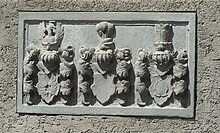Nazza Castle
The Nazza Castle is a castle and monument in the municipality of Nazza in the Wartburg district . It is located in the historical location and is privately owned.
history
The Nazza Castle was built around 1550 as a farm yard with a representative residential building by the von Hopffgarten gentlemen on Haineck zu Nazza . Haineck Castle , located above Nazza, was at that time the official seat of the Wettin Castle Office and was received by the Knights of Hopffgarten as a fief and at times as a pledge. In 1513, the sovereign Duke Friedrich the Wise handed over Haineck Castle and the associated property and rights to Georg von Hopffgarten, who was a knight of the Order of Malta, Privy Councilor and Haineck bailiff. He became the progenitor of the branch from Hopfgarten to Haineck zu Nazza.
After the Peasants' War , which had spread to the area of the Haineck Office, the subjects of the Office had to pay 760 guilders fines as atonement for the suppression of the peasant uprising. At this point the military value of Haineck Castle had declined, but the shock of the first siege of Vienna by the Turks in 1529 had also alarmed the Saxon rulers, and the emperor asked them to restore the existing fortifications and castles .
At this time the Lords of Hopffgarten began to move their residence to the outskirts, administrators and servants remained in the castle to guard. A stone tablet with the chronogram 1551 commemorates the inauguration of the castle building by Georg Christoph von Hopffgarten and his wife Elisabeth von Greußen. His son Georg Wilhelm von Hopffgarten was married twice. He arranged for the further beautification of the Nazza Castle, which shows his alliance coat of arms.
Jurisdiction over the place Nazza remained in the hands of the von Hopffgarten family until 1815, the place was an exclave to the Duchy of Saxe-Gotha . Forester Hans Ernst von Hopffgarten, who was a wealthy forest owner, was the last owner of the property and sold the buildings in 1816 with the consent of his cousins. After the dissolution of the Hopffgarten court , Nazza became the seat of the Nazza state court office in 1839, which in 1869 was subordinated to the district court in Thal . In 1835, the Nazza community received ownership of the Haineck castle ruins.
Only a small remainder of the original building complex of the Nazza Palace remained; the stables, barns and storage buildings built as a four-sided courtyard took up the northern part of the manor complex, it reached up to the steep slope of the Lempertsbach and was also accessible from the north by a side path (Triftweg) . The southern block consisted of four houses grouped around a rectangular courtyard, each with a massive ground floor with attached half-timbered lofts and served as a stately residential palace.
literature
- Georg August Galetti: History and description of the Duchy of Gotha . Third part. Gotha 1780, Hopfgartensche and some other courts around it, p. 161 ff .
- Rainer Lämmerhirt 600 years of Haineck Castle , Festschrift, Nazza 1991
- Rainer Lämmerhirt: The forgotten Hopffgarten palace at Nazza . In: Mihla municipal administration (ed.): WERRATAL news . Number 13. Verlag und Druck Linus Wittich KG, Fritzlar 2009, p. 18-19 .
Coordinates: 51 ° 6 ′ 55.2 ″ N , 10 ° 20 ′ 12 ″ E

